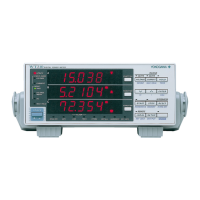14-6 IM 760401-01E
When Consecutive Commands are in the Same
Group
This instrument stores the hierarchical level of the
command which is currently being executed, and
performs analysis on the assumption that the next
command to be sent will also belong to the same level.
Therefore, it is possible to omit the header if the
commands belong to the same group.
Example
DISPLAY1:FUNCTION V;ELEMENT 1<PMT>
When Consecutive Commands are in Different
Groups
A colon (
:) must be included before the header of a
command, if the command does not belong to the
same group as the preceding command.
Example
DISPLAY1:FUNCTION V;:SAMPLE:HOLD ON<PMT>
In Case of Consecutive Common Commands
Common commands defined in IEEE 488.2-1992 are
independent of hierarchical level. Thus, it is not
necessary to add a colon (:) before a common
command.
Example
DISPLAY1:FUNCTION V;*CLS;ELEMENT 1<PMT>
When Separating Commands by <PMT>
If a terminator is used to separate two commands,
each command is a separate message. Therefore, the
common header must be typed in for each command
even when commands of the same command group
are being sent.
Example
DISPLAY1:FUNCTION V<PMT>DISPLAY1:
ELEMENT 1<PMT>
Upper-level Query
An upper-level query is a compound header to which a
question mark is appended. Execution of an upper-
level query allows all settings of one group to be output
at once. Some query groups comprising more than
three hierarchical levels can output all their lower level
settings.
Example
INTEGRATE?<PMT> ->
INTEGRATE:MODE NORMAL;
TIMER 0,0,0<RMT>
In reply to a query, a response can be returned as a
program message to this instrument.
Header Interpretation Rules
This instrument interprets the header received
according to the following rules.
• Mnemonics are not case sensitive.
Example “
FUNCtion” can also be written as
“
function” or “Function.”
• The lower-case part of a header can be omitted.
Example “FUNCtion” can also be written as
“
FUNCT” or “FUNC.”
• If the header ends with a question mark, the
command is a query. It is not possible to omit the
question mark.
Example “
FUNCtion?” cannot be abbreviated to
anything shorter than “FUNC?.”
• If the “
x” at the end of a mnemonic is omitted, it is
assumed to be “1”.
Example If “ELEMent<x>” is written as “ELEM,” this
represents “
ELEMent1.”
• Any part of a command enclosed by [ ] can be
omitted.
Example
[CONFigure]:SCALing[:STATe] ON
can be written as “SCAL ON.”
• However, a part enclosed by [ ] cannot be omitted if
is located at the end of an upper-level query.
Example “
SCALing?” and “SCALing:STATe?”
belong to different upper-level query
levels.
14.2 Program Format

